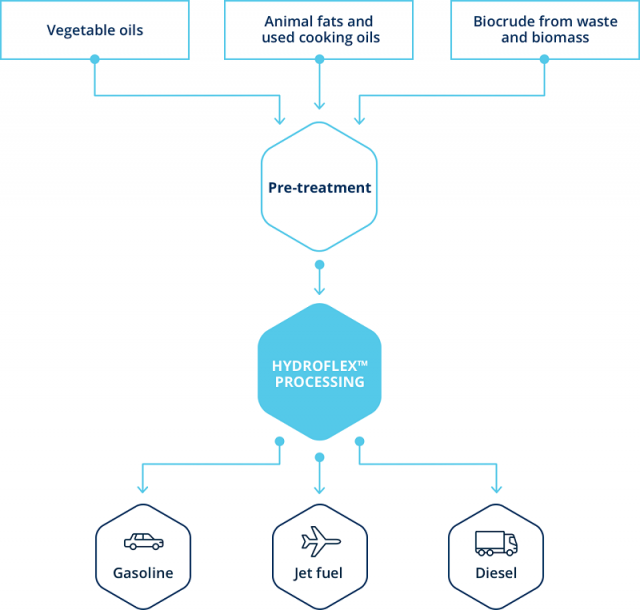Indaba Renewable Fuels to produce 6,500 barrels per day SAF in 2 locations using Haldor Topsoe tech

News just in that Indaba Renewable Fuels will build two greenfield refineries in California and Missouri to produce Sustainable Aviation Fuel utilizing Topsoe’s HydroFlex technology. The facilities are expected to begin production of SAF in 2024 with the capacity of the plants expected to be 6500 barrels per day at each location. Topsoe will also provide its H2bridge hydrogen technology for both facilities that further replaces fossil fuels with renewable liquids like LPG or naphtha to lower the carbon intensity of the products.
In today’s Digest, who is Indaba Renewable Fuels and their ties to 2 other renewable fuel companies, where will this renewable fuel will go, the project timeline, a look at the Haldor Topsoe tech, reactions from the stakeholders, and more.
Who is Indaba?
Based in California, Indaba Renewable Fuels is a waste to diesel company that converts plant and animal oil, fats, and grease-based feedstock into renewable diesel fuel. According to their website, “Indaba uses a patented and proven technology platform, which enables the company to provide the most environmentally clean and economically efficient production of sustainable aviation fuel.”
Indaba is constructing a new renewable diesel refinery that will produce high grade, low carbon footprint, ultra-low sulfur “drop in” renewable diesel and jet fuel. This includes monetizable by-products such as naphtha and propane. “This plant will set a new industry standard for renewable diesel and sustainable fuel generation,” according to Indaba’s website. 100% of the “Drop-In” renewable Diesel from the California location is designated for delivery to the California market.
Indaba has licensed technology from Haldor Topsoe, using their trademark “HydroFlex” which allows the refinery to use a variety of fatty acid-based products as feedstock (refinery inputs). These feedstock inputs include brown, yellow or white greases, vegetable oils, corn oil and animal fats.
A look at the Indaba team is an interesting mix of fossil fuel, solar and biofuel folks like Geoff Hirson, CEO who has experience in tar sands and solar power projects and holds 12 patents. Even more fascinating is Hirson’s LinkedIn profile which lists him as CEO of St. Joseph Renewable Fuels in Cook County, Illinois and President of Powerdyne Renewable Fuels in Terre Haute, Indiana. So it will be interesting to see if there is any activity with those other companies in the future as well.
We found this article from May 2020 that St. Joseph Renewable Fuels was planning on building a renewable diesel plant in Southern Illinois with an investment of $400 million. Being developed together with the City of Newton, Illinois, the new facility will be built on a 40-acre site within a federally designated opportunity zone. The facility will be equipped to consume waste fats and greases in Newton that would be otherwise be landfilled or emptied into sewer drains. The plant will have the capacity to convert the waste into 90 million gallons of diesel and naphtha fuel annually as well as seven million gallons of technical grade glycerine. The project is backed by financing from speciality finance firm Lance Capital and its New Zealand joint venture partner, Lance-Kamaka Capital. The project partners include Cyberus Labs, which delivers the technology component of the healthcare platform, and a joint-venture between McDermott and Chevron Oil which will provide the core technology of the renewable fuels produced.
And we found this article from December 2014 that said Powerdyne Renewable Fuels would be investing hundreds of millions of dollars to construct a Sewage-to-Diesel Fuel Facility in Terre Haute, Indiana, but we haven’t heard any updates since then.
The timeline
From the initial permit application, it is anticipated to take approximately 4 to 6 months to obtain all necessary permits for the construction of the California manufacturing facility, renewable power and renewable fuel project. An EPC contractor has been engaged by Indaba Renewable Fuels California LLC. It is currently completing a design that is used on a similar plant owned by a sister company. The use of a similar design for the new plant, could speed up the permit process. Once completed, Indaba will have immediate and exclusive rights to this design. Even though the facility will not be operational for two years, management believes that all projections are conservative and obtainable.
The new Indaba Renewable Fuels refinery will be developed by Indaba Renewable Fuels California Manufacturing LLC with its EPC contractor over the course of 26 to 28 months. Here is the timeline listed on their website:
- Pre-development phase through January 2022 – Pre-development period includes refinery property due diligence currently in escrow
- Lance Capital Funding Closes January 2022 – All contracts signed with contractors, partners, insurers
- Project fully funded & monies released to EPC February 2022
- Construction begins February 2022 – 24 to 26 months construction
- Refinery commissioning between April – June 2024
No additional information on the Missouri facility could be found online as of yet.
A look behind the technology
With HydroFlex, refiners can convert low value feedstocks to renewable fuels that qualify for Low Carbon Fuel Standard (LCFS) credits. The innovative HydroFlex process layout offers lower capital expenditure (CAPEX), but also a lower energy consumption during operation, resulting in a lower Carbon Index (CI). That sure makes it attractive in many ways!
Topsoe’s H2bridge hydrogen technology is based on a modular and highly efficient convection reformer technology. It delivers a circular solution to refineries and biorefineries by replacing fossil feedstocks with renewable LPG or naphtha to produce renewable hydrogen, thereby generating significant greenhouse gas emissions savings and lower the carbon intensity of the renewable fuels produced in the HydroFlex unit.
The solution enables Indaba’s facilities to accept a wide variety of feedstocks as well as the production of multiple low carbon Index (CI) renewable fuels.
You can read more about HydroFlex and H2bridge here.

Reactions from the stakeholders
“We are excited to provide Indaba with refining technology and catalysts as they initiate production of renewable fuels in the United States. Our HydroFlex solution is designed to produce sustainable aviation fuel (SAF) based on renewable feedstock, with a minimal Carbon Intensity (CI score) compared to traditional petroleum aviation fuel,” says Henrik Rasmussen, Managing Director, The Americas, Haldor Topsoe Inc.
“We are thrilled to select Haldor Topsoe’s market-leading HydroFlex technology for these projects that will enable us to lead the aviation industry’s transition to sustainable and low emissions fuel. These projects will source feedstocks from waste products to create low carbon emission SAF for decades,” says Geoff Hirson, Chief Executive Officer, Indaba Renewable Fuels.
Bottom Line
Indaba producing SAF is much needed as we all know the demand is there for SAF from airlines and airports around the world, and the key is scaling up enough production to meet the demand. What will be interesting to see are the details on the Missouri location and if Indaba’s CEO Geoff Hirson has any news on his other two renewable fuels companies, St. Joseph Renewable Fuels in Illinois and Powerdyne Renewable Fuels in Indiana which would further help boost SAF fuel production to meet the growing demand.
Category: Top Stories















